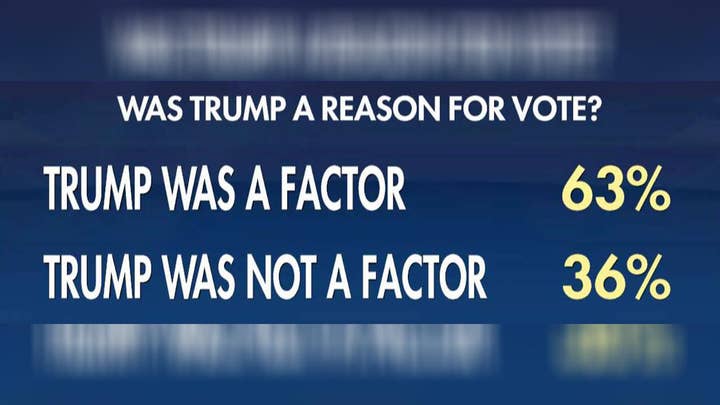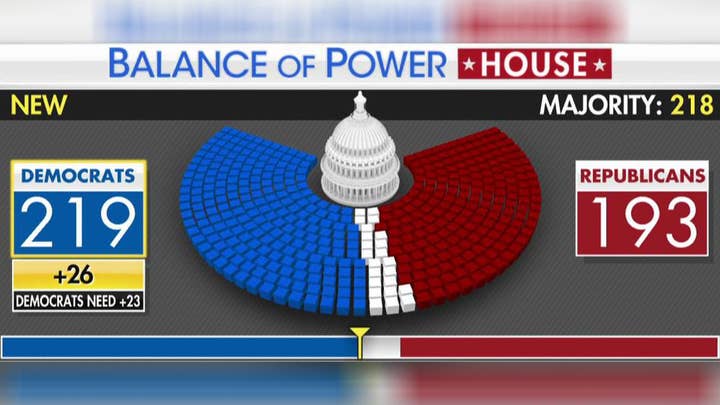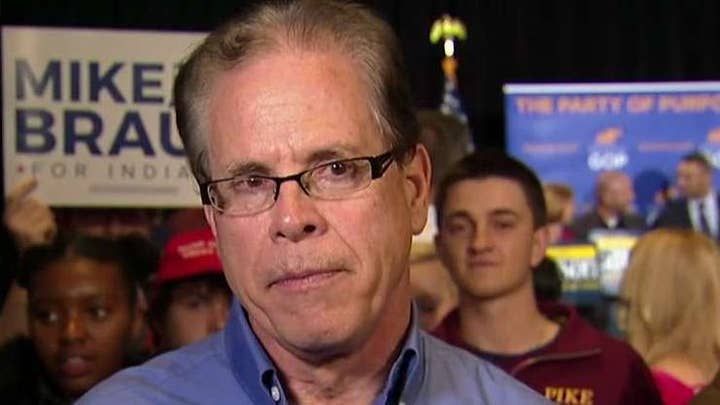Will a divided Congress be able to unite on anything?
Amy Kremer, co-founder of Women for Trump, and Wendy Osefo, Democratic political analyst, join the debate.
In an election reflecting the country’s deep partisan divide, voters across America handed the keys to the House of Representatives to the Democrats, while Republicans took advantage of a favorable Senate map to expand on their majority in the Senate.
It was an unusual but not unprecedented outcome for a midterm election. The House and Senate have moved in opposite directions in a midterm just three times since World War II. The last time was 1982, when Democrats gained 27 seats in the House and Republicans picked up one in the Senate.
CLICK FOR THE FULL FOX NEWS VOTER ANALYSIS
Democrats picked up more than 30 House seats, gaining control of the lower chamber for the first time since the party’s self-described “shellacking” in 2010. The vote – at least for the House – served as a rebuke to President Donald Trump, as more said their vote was intended to express opposition to Trump than support for him.
The battle for the Senate was largely fought in states Trump won in 2016 and where voters still have a favorable opinion of the president. Those tailwinds were critical for the GOP, which expanded on its majority in the upper chamber.
The gender gap – a prominent feature of the last several elections – was a notable factor in this year’s House races as well. Women preferred Democratic candidates by a 14-point margin, while men picked Republicans by six points.
College-educated women (+26 points) and suburban women (+17 points) both went strongly for Democrats, but white women backed Republicans by a four-point margin.
The urban-rural divide was even more notable, as city dwellers backed Democrats by 34 points, while rural voters went for Republicans (+16 points).
A strong showing from younger voters and nonwhites also helped tip the scales to the left. Voters under age 30 made up 12 percent of the electorate, and they backed Democrats by 25 points.
Democratic candidates also racked up large margins among black voters (+79 points) and Hispanics (+29 points).
White voters broke for Republicans, 53-42 percent. In particular, the GOP held double-digit advantages with white working-class voters (+21 points), white men (+19 points), and whites over age 45 (+17 points).
Republican candidates also chalked up wide wins among gun owner households (+22 points), white evangelicals (+61 points), and conservatives (+72 points). But strong base support was not enough for Republicans to hold the House, as moderates favored Democrats, 57-35 percent.
Nearly all Democrats (95 percent) voted blue, while Republicans went red at a slightly lower clip (91 percent). That difference in party loyalty, combined with a 9-point Democratic edge among independents, proved decisive.
The Key Issues
The top issues in voters’ minds this election were health care (26 percent) and immigration (23 percent). The economy placed third at 19 percent.
Health care voters favored House Democratic candidates by a 50-point margin, and Democrats also had sizable advantages among those most concerned with gun policy (+61 points) and the environment (+72 points). Republicans won immigration voters by a wide margin (+58 points) and economy voters by a narrower 58-36 percent spread.
Just over half of voters (52 percent) would repeal all or part of the Affordable Care Act, and these voters broke for Republicans by 56 points. Nearly as many would either leave the law as is (13 percent) or expand it (34 percent). They backed Democrats by an even wider margin (+73 points).
Overall, more voters said it should be the government’s responsibility to provide health care for all Americans (58 percent) than said it should not (41 percent).
The president focused on immigration down the home stretch of the campaign, and immigration voters broke for Republicans. But overall, voters were more likely to think immigrants help the country (59 percent) than hurt it (39 percent), and more opposed Trump’s signature border wall proposal (47 percent favor vs. 52 percent oppose).
By a 39-point margin, voters believed immigrants living in the U.S. illegally should be offered a chance to apply for legal status, not deported.
The focus on immigration may have shifted attention away from the economy. Strong October jobs numbers brought unemployment to its lowest level in nearly 50 years, and voters were more likely to give positive ratings on the economy than negative ones.
Those who gave a positive grade to the economy opted for Republicans (+24 points), while voters with a negative view broke for Democrats (+56 points).
Despite the strong economy, a majority of voters – 63 percent – said they are holding steady financially, far more than the 20 percent who are getting ahead.
Seven-in-ten voters (70 percent) said the country’s economic system favors the wealthy too much. A similar number said the economy does not do enough to favor the middle class (69 percent) or the poor (63 percent).
Reactions to Trump’s economic accomplishments were mixed. The 2017 tax reform law were evenly split (48 percent approve and 48 percent disapprove), but more voters thought Trump’s policies on trade have hurt the national economy (48 percent) than helped it (40 percent).
The bitter battle over Brett Kavanaugh’s nomination to the Supreme Court was, without a doubt, a motivating factor for voters. Three-quarters (74 percent) said the debate was important to their decision to vote. Nationally, these voters backed Democrats by a 52-43 percent spread – but broke for the Republican in several hotly contested Senate races.
The dramatic nomination hearings amplified the national conversation about sexual misconduct. In the aftermath, voters expressed concern about women not being believed when making allegations of misconduct (43 percent very concerned) and about men not having the opportunity to defend themselves (38 percent).
Opinions of Donald Trump
Midterm elections are often seen as referendums on the sitting president, and fully 63 percent said Trump was a factor to their vote this year. By an eleven-point margin, more said they voted to express opposition to Trump than support for him.
That tracks with views of Trump nationally, as a 54-45 percent majority disapproved of the job he is doing as president.
The vast majority of Trump approvers voted for Republican House candidates (86 percent), and a similar number of disapprovers went for Democrats (83 percent).
Trump’s midterm report card on the issues might not be one to pin on the fridge. Voters gave net negative ratings on his handling of health care (-16 points), immigration (-8 points), international trade (-7 points), and Supreme Court nominations (-1 points). He was in positive territory on the economy (+8 points) and border security (+1 point).
On the list of positives for the Commander-in-Chief, an overwhelming majority said he stands up for what he believes in (72 percent). However, majorities also indicated he lacks the temperament for the job (64 percent), is not honest and trustworthy (62 percent), and does not care about people like them (58 percent).
What does all that mean for his reelection prospects? With two full years before the next presidential election, more voters said they would back a Democrat (41 percent) than would back Trump (34 percent). But a sizable bloc said it would depend (24 percent), and those voters broke for Republican House candidates 50-35 percent.
Mood of the country
Democrats’ win in the House came as large numbers of voters expressed concern about the future. A majority (56 percent) said the country is headed in the wrong direction, and voters thought life for the next generation would be worse rather than better by 25 points.
Pre-election violence and disorder likely contributed to the feeling that things are off the rails. Voters said the way partisans on both sides talk about politics is leading to an increase in violence. However, 37 percent only blamed Republicans, compared to 30 percent who only blamed Democrats.
The depths of the partisan divide go even deeper. Just 13 percent of Republicans thought Democrats mostly try to do what’s right for the country instead of what’s best for their party. Democrats took a similar view of Republicans (11 percent). Independents gave Democrats slightly more credit than Republicans for trying to do the right thing (39-35 percent) – but did not have a particularly charitable view of either side.
One area of bipartisan agreement: only two-in-ten voters (19 percent) said they trust the government to do what’s right most of the time. That explains why more than seven-in-ten (71 percent) were either dissatisfied or angry about the way the federal government is working.
Nonvoters
The election outcome depends on who turns out, as well as who stays home. So what about those who didn’t cast a ballot this year? Unlike a traditional exit poll, the Fox News Voter Analysis surveyed nonvoters as well, and provides a window into who decided not to vote, why not, and how they would have voted if they had turned out.
Demographically, nonvoters were more likely to be younger, nonwhite, without a college education, and politically independent.
Nonvoters were also more likely to have voted for Trump in 2016 (47 percent for the president and 33 percent for Clinton), suggesting that Trump voters were more likely to stay home this year than Clinton voters.
If they had made it to the ballot box, the overall group of nonvoters said they would have opted for the Democratic candidate in their district by a 36-32 percent margin.
As for why they didn’t vote, the top reasons were not knowing enough about the candidates (30 percent), not liking politics (30 percent), and the feeling that their vote did not matter (14 percent).
While voter identification laws became a flash point in several campaigns, most notably in the contest for governor in Georgia, just three percent of nonvoters said they did not vote because they lacked the proper identification.
Florida
The Sunshine State – also known as the home of close contests. Trump won in 2016 by a little over 1 percentage point. In 2012, Obama won by slightly less than 1 percentage point. And who could forget 2000, when George W. Bush won by a hanging chad?
Tonight, Republicans eked out two close wins. In the race for governor, former U.S. Representative Ron DeSantis edged out Tallahassee Mayor Andrew Gillum. And in the Senate, former Governor Rick Scott unseated incumbent Bill Nelson.
President Trump was not on the ballot, but voters used their votes to send a message. Two-thirds (65 percent) said the president was a factor in the race for Senate, but he may not like the effect he had on it, as more voted in opposition to Trump than in support of him (36 percent to 29 percent). Nine-in-ten voters (91 percent) had the eventual control of the senate on their minds.
Florida voters differed on the top issue facing the country. Roughly a quarter said immigration (26 percent) was the top issue, and another quarter cited health care (24 percent). The economy came in third, at 17 percent. Health care voters broke three-to-one for Nelson; 80% of immigration voters went for Scott; economy voters went two-to-one for Scott.
Gun policy was selected by 10 percent.
Gun violence has rocked Florida repeatedly, including the Pulse nightclub shooting, Parkland, and most recently a shooting at a yoga studio. Fully 68 percent want stricter gun laws. These voters must feel Governor Scott did not do enough here, as 68 percent of them went for Nelson.
Both candidates had a record on healthcare: Nelson voted against repealing ObamaCare, while Scott declined to expand Medicaid as governor. Like the candidates, voters differed on repealing the Affordable Care Act: 54 percent favored repeal and 45 percent wanted to leave it as is or expand the law.
Most Florida voters (67 percent) felt immigrants living in the U.S. should be given a path to citizenship. Far fewer (31 percent) said illegal immigrants should be deported back to the country them came from. A majority also said immigrants do more to help the country; few felt they hurt.
Hispanic voters, a sizeable group whose support was sought by both parties, went narrowly for Nelson (51-44 percent). Seniors broke for Scott. Young people, a smaller percentage of the electorate than seniors, sided with Nelson.
Indiana
In Indiana, Republican challenger Mike Braun flipped the Senate seat held by Democrat Joe Donnelly in a state President Trump carried by 19 points in 2016.
Women voters were expected to have an impact in these midterm elections, but for Braun it was men who made a difference. Men and women each made up half of the Indiana electorate, but men went for Braun 55 percent to 40 percent.
Women went narrowly for Braun as well, with 49 percent to Donnelly’s 46 percent.
Independents were also expected to play a key role in tight races like Indiana’s, but in this case they went for the losing candidate. Republicans, however, made up a larger share of the electorate – 54 percent, compared to 33 percent for Democrats and 13 percent for Independents. And those voters went for Braun.
The debate over the Kavanaugh nomination to the Supreme Court was important to 77 percent of Indiana voters, and among those voters 54 percent went for Braun over 44 percent for Donnelly.
Missouri
Democrat Claire McCaskill lost her Senate seat to Republican challenger Josh Hawley. In a state President Trump carried by 18 points in 2016, McCaskill’s attempts to distance herself from far-left elements of the Democratic party in the final weeks of the campaign turned out not to be enough.
President Trump told voters to act as though he were on the ballot, and Missouri voters took that to heart. Fifty-four percent of them approve of the job he is doing – and they broke big for Hawley, 87 percent of them.
Among the top issues for Missouri voters was the economy, and more than two-thirds of them are feeling pretty good about it. Those voters broke for Hawley 65 percent to 31 percent for McCaskill.
The Kavanaugh Supreme Court nomination was also an important issue to 74 percent of Missouri voters. Those voters broke for Hawley by a five point margin.
Texas
Incumbent Republican senator Ted Cruz held his seat after a bruising battle with Democrat Beto O’Rourke. The two men represented opposite ends of the political spectrum. Fully half said O’Rourke’s positions on the issues were too liberal.
O’Rourke was for expanding ObamaCare; Cruz staged the infamous 2013 filibuster during the Senate debate on the Affordable Care Act, and voted to repeal it. Texas voters agreed with Cruz: a strong majority, 57 percent, favor repealing all or parts of that law and they gave Cruz 78 percent of their votes.
A narrow majority of Texans backed the president’s plan for a border wall, and these voters gave Cruz 90 percent of their votes. Ten percent of anti-wall voters backed Cruz as well. Fifty-five percent approve of the job Trump has done on border security.
Half the households in Texas reported owning guns. Cruz, a gun-rights supporter, garnered support from 58 percent of gun households. O’Rourke, who ran on universal background checks, was supported by 39 percent.
Party control of the senate was very important to three-quarters of Texans. These voters broke slightly for Cruz.
Hispanics were almost one-quarter of the electorate. They strongly favored O’Rourke, 67 percent to 29 percent. White men, about one-third of the voters, went for Cruz 70 percent to 28 percent. Voters in small towns and rural areas favored Cruz, too, 61 percent to 36 percent.
Methodology
The FNVA is a survey of the American electorate conducted in all 50 states by NORC at the University of Chicago for Fox News and The Associated Press. The survey of 116,789 voters and 22,137 nonvoters was conducted Oct. 29 to Nov. 6, concluding at the end of voting on Election Day. It combines interviews in English and Spanish with a probability sample of registered voters drawn from state voter files, samples of self-identified registered voters from a probability-based national panel, and samples of self-identified registered voters from opt-in online panels. Participants selected from state voter files were contacted by phone and mail and had the opportunity to take the survey by phone or online.









